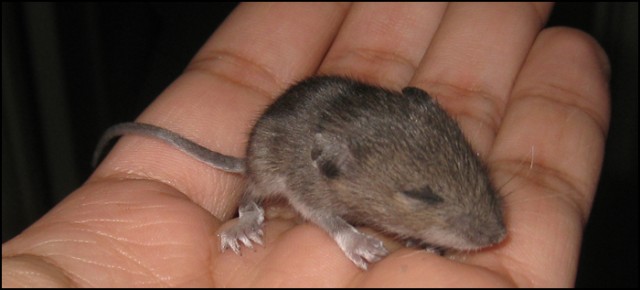I learned something from a mouse the other day.
No, not Mickey, Modest or Mighty.
This was a real mouse — a baby, as a matter of fact — covered in grey fur and smaller than my thumb.
When I tell you what I learned and how I learned it, some of you will no doubt think I’ve dunked my head into a pot of maudlin schmaltz, while others may settle for a quick roll of the eyes. But bear with me as I try to bring the big picture into focus.
The lesson began a couple of days earlier. I was preparing to finish remodeling the staircase that leads from our garage to the basement, and was moving things into the basement, out of the way. When I got to the bottom of the stairs, I noticed the mousetrap; and the dead mouse. I really didn’t give it much thought as I placed the lifeless creature in a plastic bag, put the bag in the garbage can outside and returned to my work.
Quick Aside
If the pace of projects I pursue around the house with hammer or paintbrush in hand were described in musical terms, the most salient word would be adagio, as in, “This enterprise is to be performed slowly.”
Forget Ishmael. Call me Maestro.
Whatever.
The remodeling continued anything but apace, and two days later I found myself in the same staircase, applying a second coat of paint. As I moved the ladder, I happened to glance at the bottom of the stairs.
There was another dead mouse, only this time the mousetrap wasn’t involved. I set my tools aside, grabbed another plastic bag and descended the steps to remove the little creature. Only this time the mouse wasn’t dead. The moment I touched the mouse he kicked his legs and wriggled.
And then it hit me. This was a starving, baby mouse, and it had crawled to within a foot of the place where its mother was killed in a trap two days earlier.
Okay, I already know this is where some of you are going to get off the train. Some of you will wander off because … well … c’mon, get a grip; it’s just a mouse. Others may depart because it IS a little mouse, and you don’t want to read something sad.
For those who choose to continue reading, let me assure you my flinty heart was turned to mush the moment I realized what had happened. I carefully scooped the baby mouse into my hand and climbed the stairs, trying to figure out what to do.
I’ll keep this part short. In the end, after spooning tiny amounts of water and slightly warmed ½ & ½ into the little mouth, I watched the mouse kick and sputter and then move no more. The probability that my ham-fisted attempts at succor had actually hastened the end did not escape my contemplation.
A profound sense of sadness wafted over me.
Quick Aside
Yes, I’m quite aware that I was the one who set the trap that killed the mother mouse. The truth is, I embrace a laissez-faire, “Live and let live” philosophy regarding creatures around my home. I have numerous feeders that keep whole hosts of birds and a large number of squirrels in fairly decent and chubby health. But I do draw the line when the outside creatures attempt to dwell inside with me. Based upon my experience, it is quite easy (yea, predictable) to go from a couple of cute mice scampering about the basement, to an uncontrollable herd that finds every nook and cranny access to the house above and wreaks poop-laden havoc.
Compromise is the unspoken maxim to which I adhere.
At any rate, a feeling of contemplative melancholy draped my thoughts as I pondered the tiny life that had just expired in my palm.
Where did it go? Where did it come from?
Most of us rarely or never consider the scads of ubiquitous, non-human life that surrounds and fills our planet. And when we do reflect upon that life, we tend to consign increasing importance proportional to that life form’s relationship to our species. But the little mouse got me to thinking about life irrespective of its relationship to humanity, and a thought occurred to me:
We truly don’t know the first thing about it.
Granted, we have a fairly good handle on identifying things that are alive and things that are not alive, but even that simple understanding is not perfect. There are things that defy our best attempts at classification. And the unapproachable realities of life remain: Where does life come from? Where does it go? Why is it here? Is it elsewhere?
So I ponder.
And one of the things that crossed my mind was the apparent rareness — at least to our present knowledge and understanding — of life throughout the Universe. We have yet to discover any sign of it anywhere else. No matter where, when or how we aim our various detecting devices into the sky, thus far we have found nothing. If we were forced to draw a conclusion based upon what we have uncovered, we would have to conclude that Earth is it; life — as we define the term — does not exist anywhere else.
That, truly, seems preposterous, given what we do know about the unfathomable depth and breadth of the Universe, and the wondrous natural incompatibilities that float about its ether, but if we are honest and unbiased, it is the only conclusion we can make based upon the facts we know.
As I considered that possibility, I let my thoughts wander a bit further: Suppose all the forms of life on our planet were suddenly unfastened from one another and splintered into their smallest, still-living structure? In other words, the overall mass of life remained the same, but all Life is now represented in its tiniest form. Sort of like deconstructing something made of a huge collection of Legos into nothing but individual Lego pieces; they’re still identifiable as Legos, but nothing more.
Now imagine if that mass of little bits of life were evenly and proportionally scattered throughout the Universe so that each little Lego piece of life was equidistant from its nearest neighbor, all over and around the Universe. You now have tiny representatives of life suspended in their own three-dimensional chunk of space, equally distant from their closest neighbor in every direction.
The total number of tiny Lego life representatives taken from Earth would be, (I presume), an incomprehensibly large number, but even that enormous amount would, (again I presume), pale in comparison to the presently known (and expanding) volume of the Universe. And that makes me wonder:
How far apart would those little pieces of life be from one another?
I’m neither a scientist nor a mathematician, so I have no idea, but I suspect nearest neighbors would be well beyond hailing distance. I could be wrong, of course, but my gut tells me that gauging even the shortest distance between two microscopic life forms would require a tape measure with light year increments. And if that was true, that would be one more way to visualize just how rare life is within the Universe.
In that context, is life the rarest of all things?
Who knows? But unless and until we find a colossal galaxy chockablock with solar systems that are bursting at the seams with planets that are themselves awash and knee-deep in creatures, (not to mention the “No Vacancy” sign hanging on its borders), what we have here on Earth — life — is a scarce commodity throughout the universe.
That being the case, perhaps we — the creatures made up of significant numbers of those wondrous Lego blocks that have amalgamated themselves together and somehow become self-aware — should give a bit more thought to how we think about, provide for and otherwise nurture it.
A little mouse died in my hand, and in its passing the tiny creature proctored my soul.
Ah, Fates, the clement irony.






